How to Release Jaw Pain and #DelosYourself to Relax Your Facial Muscles
Your down jacket is at the front of your coat closet, your coziest scarf is on repeat, and you’ve gotten in the habit of saying “Phone, wallet, keys, gloves, hat,” before you leave the house. And yet somehow, the cold still gets to you and your teeth are chattering away as you walk to work or wait for your ride. It’s officially that time of year — and that can mean an increase in jaw pain.
What causes jaw pain?
Jeri McCombs, DMD and friend-tist to aSweatLife, explained to us exactly what jaw pain is and what causes it.
“Jaw pain is a lot of times referred to as ‘TMJ.’ The truth is that everybody has a TMJ (two temporomandibular joints actually!). Where we come to have an issue is what we call TMD (Temporomandibular Disorder) where the joint has something happening with it that causes pain or lack of function- basically it isn’t doing what it’s supposed to do.”
Most of the time, the jaw pain is muscular and stems from the masseter, which connects your cheekbone to the bottom of your jaw. And just like any other muscle in your body, notes Dr. McCombs, this muscle can be overworked and become fatigued and cramp.
“Unlike being able to rest a sore quad for a few days, your jaw is in constant use eating and talking, so if it’s getting extra work at nighttime from stress grinding or clenching, it can cause chronic and sometimes intense pain that often can cause headaches and earaches,” points out Dr. McCombs. “Clenching and or grinding is most often caused by stress, though some people are prone to do it more often than others.”
“We’ve been seeing a lot of jaw pain lately,” adds Eric Owens, co-founder of Delos Therapy. “I think people are stressed out with the cold, so they’re grinding their teeth or chattering their teeth,” all of which reduce muscle pliability and cause that tight pain in your jaw.
Another unpleasant side effect of the cold? Hunched-over shoulders as you try to burrow into yourself for warmth and block as much of that ungodly cold wind as you can.
“Everything just gets tighter in the cold. Inflammatory conditions seem to be on the rise whenever it’s cold, so arthritis always seems to be worse in the cold,” explains Owens.
Can jaw pain affect other areas of your body?
Definitely, says Owens. Most notably, jaw pain might lead to headaches, neck pain, or radiating pain to the face.
“During jaw pain, you’re pulling on your temporalis muscles, and jaw pain pulls and puts pressure throughout the face. You get a bunch of tightness that’s pulling that connective tissue. That turns to anterior pain in headaches, which you’ll feel around the forehead, sinuses, and eye area,” Owens says.
Adds Dr. McCombs, “Headaches are very common with jaw pain, and sometimes people can even get earaches.”
Plus, any pain in your jaw is going to make two of our favorite things very difficult and probably painful: eating a drinking. You might also feel pain opening or closing your mouth.
“The jaw muscles are big, powerful muscles,” Owens points out. “They get a lot of use. Every time you eat or talk, those muscles are being engaged. If you’re a clencher or a grinder at night and you’re doing that eight hours a night — yeah, that’s going to leave you a bad jaw.”
What happens if jaw pain is left untreated?
Like any joint, you exert enough force around the joint and that may lead to joint degeneration.
“Since your jaw never truly gets a break, jaw pain usually doesn’t go away on its own without changing anything. Either your stressful time will pass and eventually it will get better, or you need to do some treatment to help it progress faster,” shares Dr. McCombs.
And, from a dentist-specific perspective, Dr. McCombs warns that grinding your teeth at night wears away the enamel of the teeth, which can cause permanent, irreversible shortening of all the teeth.
“This is essentially premature aging of your mouth,” she cautions. “We often see people who have basically worn their teeth down to little nubs from unchecked grinding over years, and there is no good solution. Once the tooth structure is gone, it’s gone forever- you don’t get any more back. Prevention when you’re young can prevent needing tens of thousands of dollars of extensive dental work later on- often involving crowning every tooth in the mouth to repair the damage.”
How do I treat jaw pain?
As with any other muscle therapy, Delos aims to restore muscle pliability to relieve jaw pain and loosen the tight muscles. Therefore, your Delos therapist will apply pressure to your neck, jawline, temples, and more.
Owens adds that when it comes to jaw pain, he always asks if his client has had a formal diagnosis; he views Delos as one part of a holistic treatment plan for jaw pain, not a “this or that” solution.
“A mouth guard on its own isn’t enough, and restoring muscle pliability on its own isn’t enough,” he says, arguing that a functional treatment plan will include many different approaches.
Dr. McCombs also advocates restoring muscle pliability via our favorite #DelosYourself moves at home. “Using your finger to help open your jaw wide, and move the jaw to the left and right will help as well. I recommend the compresses and stretching at minimum 3x daily, more if you can.”
Adds Dr. McCombs, “For first-time jaw pain, I usually recommend to people to go ahead and start with NSAIDs (like Ibuprofen or Aleve, not Tylenol- it doesn’t have the same anti-inflammatory effects). 600mg of Ibuprofen every six hours for 3-4 days acts as a mild muscle relaxer, and will dramatically expedite your body’s ability to clear the inflammation in the muscle. Also using warm wet compresses (like a washcloth soaked with hot water) will penetrate into the muscle and help it loosen up.”
However, she notes that if it’s a true problem with the joint itself, or a more advanced case, this regimen may not be sufficient and additional treatment, management and even surgery may be warranted — so your best bet is to talk to your trusted dentist for accurate treatment options, especially if your jaw pain is recurring (in which case you might need a night guard).
“Jaw joint problems can be very complex and there’s lots of ways to treat them- but this is my professional opinion for the majority of patients I see,” advises Dr. McCombs. Keep in mind that if these tips don’t help, don’t hesitate to seek out help from your dental team!”
How Delos treats jaw pain
Your therapist will apply pressure to your jaw, forehead, temporalis muscle, and more.
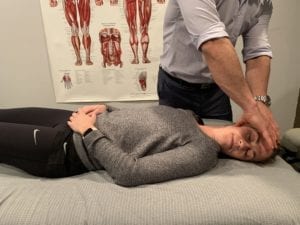
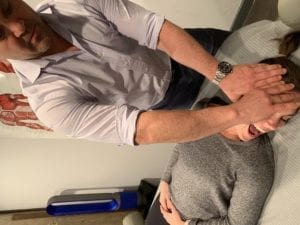

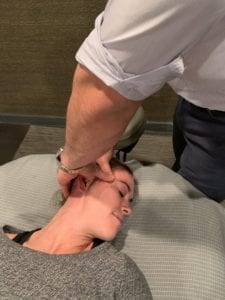
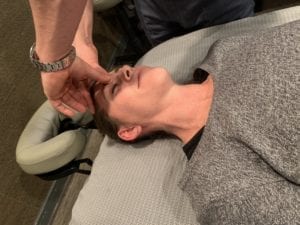
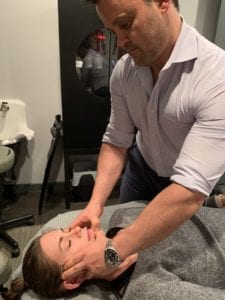
How to #DelosYourself at home
Get those thumbs warmed up — you’ll be using them to self-massage your facial and neck muscles.
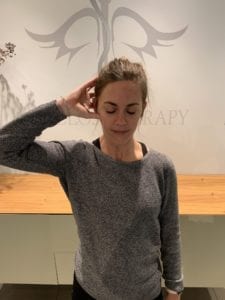



If you’re experiencing jaw pain or tightness, the wizards at Delos can help you release some of that tension. To make an appointment or learn more about how to #DelosYourself, reach out to [email protected] and tell them aSweatLife sent you.












